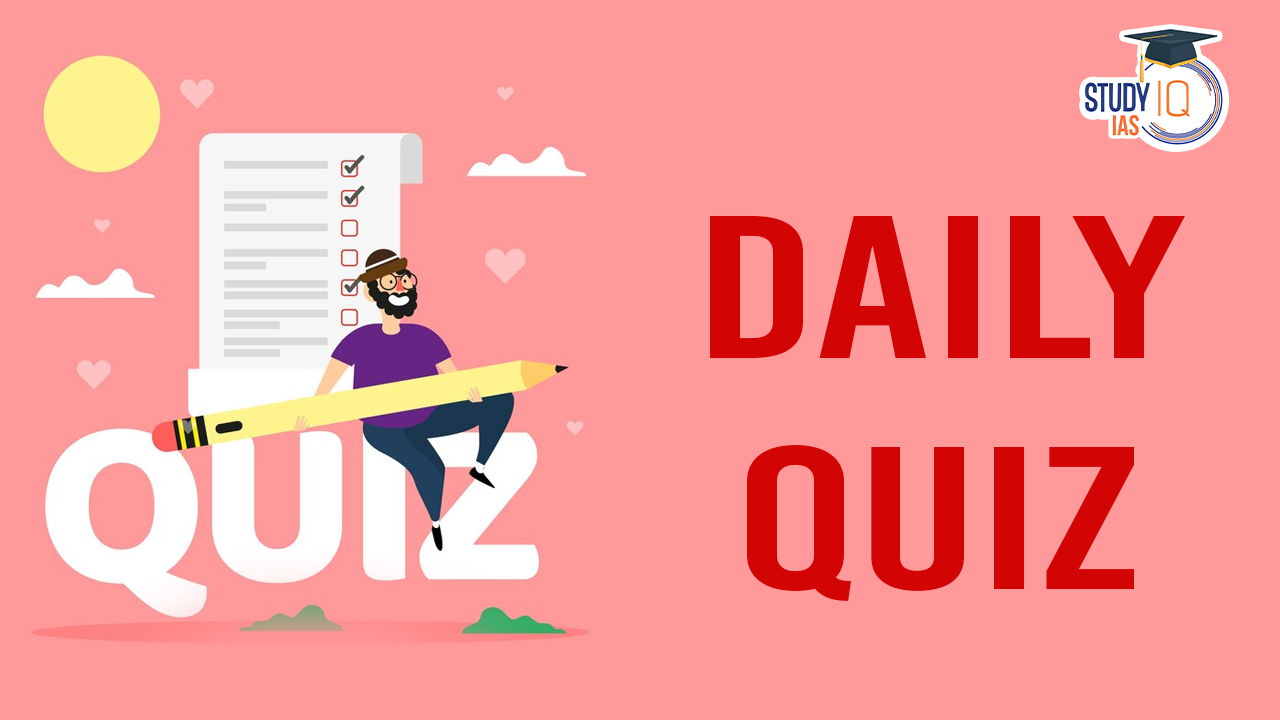Daily Quiz 19 August 2025
Quiz-summary
0 of 5 questions completed
Questions:
- 1
- 2
- 3
- 4
- 5
Information
- Click on – ‘Start Quiz’ button
- Solve Questions
- Click on ‘Next’ button
- Click on ‘Finish Quiz’ button
- Now click on ‘View Questions’ button – here you will see solutions and links.
- The test contains a total of 5 questions.
- Click on the most appropriate option to mark it as your answer.
- You will be awarded Two marks for each correct answer.
- You can change your answer by clicking on some other option.
- A Number list of all questions appears at the top side of the screen.
- You can access the questions in any order by clicking on the question number given on the number list.
- You can use rough sheets while taking the test.
- Do not use calculators, log tables, dictionaries, or any other printed/online reference material during the test.
- Do not click the button “Finish Quiz” before completing the test. A test once submitted cannot be resumed.
You have already completed the quiz before. Hence you can not start it again.
Quiz is loading...
You must sign in or sign up to start the quiz.
You have to finish following quiz, to start this quiz:
- 1
- 2
- 3
- 4
- 5
- Answered
- Review
-
Question 1 of 5
1. Question
1 pointsConsider the following statements regarding the Awaza Programme of Action (2024-2034):
- It was adopted at the Third UN Conference on Small Island Developing States (SIDS).
- It focuses on regional integration, infrastructure development, and climate adaptation for landlocked developing countries.
- Turkmenistan hosted the international conference where it was endorsed.
Which of the statements given above is/are correct?
Correct
Answer: B
Explanation:
- Statement 1 – Incorrect:
The Awaza Programme of Action (2024–2034) was adopted at the Third UN Conference on Landlocked Developing Countries (LLDC3), not at a SIDS conference. The confusion may stem from both being UN categories of vulnerable states, but LLDCs face unique logistical and trade challenges. - Statement 2 – Correct:
The Programme focuses on five priority areas:- Structural economic transformation
- Trade & regional integration
- Transport & infrastructure development
- Climate adaptation & disaster risk reduction
- Mobilising financing & partnerships
These are crucial for the 32 landlocked developing countries struggling with lack of access to seaports.
- Statement 3 – Correct:
The LLDC3 conference was held in Awaza, Turkmenistan, in August 2025, under the theme “Driving Progress Through Partnerships”.
Incorrect
Answer: B
Explanation:
- Statement 1 – Incorrect:
The Awaza Programme of Action (2024–2034) was adopted at the Third UN Conference on Landlocked Developing Countries (LLDC3), not at a SIDS conference. The confusion may stem from both being UN categories of vulnerable states, but LLDCs face unique logistical and trade challenges. - Statement 2 – Correct:
The Programme focuses on five priority areas:- Structural economic transformation
- Trade & regional integration
- Transport & infrastructure development
- Climate adaptation & disaster risk reduction
- Mobilising financing & partnerships
These are crucial for the 32 landlocked developing countries struggling with lack of access to seaports.
- Statement 3 – Correct:
The LLDC3 conference was held in Awaza, Turkmenistan, in August 2025, under the theme “Driving Progress Through Partnerships”.
-
Question 2 of 5
2. Question
1 pointsWhich of the following initiatives have significantly contributed to the reduction of train accidents in Indian Railways between 2014-2025?
- Kavach automatic train protection system
- Fog Safety Devices (FSDs)
- Ultrasonic Flaw Detection (USFD)
- Introduction of electric traction on all railway lines
Select the correct answer using the code below:
Correct
Answer: A. 1, 2 and 3 only
Explanation:
- Kavach – Correct:
This is an indigenous Train Collision Avoidance System (TCAS) developed by Indian Railways. It ensures:- Automatic braking if the train overspeeds or crosses a red signal.
- Prevention of head-on collisions and enhancement of signal compliance.
- Wide-scale implementation is ongoing, with major routes now covered.
- Fog Safety Devices (FSDs) – Correct:
These devices help loco pilots operate safely during fog, improving visibility of signals and markers. Use expanded from just 90 in 2014 to over 25,000 by 2025. - Ultrasonic Flaw Detection (USFD) – Correct:
USFD is used to detect internal rail defects before failure. It’s a preventive tool to avoid derailments, especially on heavily used routes. - Electric traction on all lines – Incorrect:
While electrification has expanded, not all railway lines are electrified yet. Also, electrification primarily improves energy efficiency and speed, but not necessarily accident prevention.
Incorrect
Answer: A. 1, 2 and 3 only
Explanation:
- Kavach – Correct:
This is an indigenous Train Collision Avoidance System (TCAS) developed by Indian Railways. It ensures:- Automatic braking if the train overspeeds or crosses a red signal.
- Prevention of head-on collisions and enhancement of signal compliance.
- Wide-scale implementation is ongoing, with major routes now covered.
- Fog Safety Devices (FSDs) – Correct:
These devices help loco pilots operate safely during fog, improving visibility of signals and markers. Use expanded from just 90 in 2014 to over 25,000 by 2025. - Ultrasonic Flaw Detection (USFD) – Correct:
USFD is used to detect internal rail defects before failure. It’s a preventive tool to avoid derailments, especially on heavily used routes. - Electric traction on all lines – Incorrect:
While electrification has expanded, not all railway lines are electrified yet. Also, electrification primarily improves energy efficiency and speed, but not necessarily accident prevention.
-
Question 3 of 5
3. Question
1 pointsWith reference to the Digital Agriculture Mission (DAM), consider the following statements:
- The mission aims to build a Digital Public Infrastructure (DPI) specifically for the agriculture sector.
- Farmer IDs generated under DAM are being used for credit, insurance, and procurement schemes.
- The Agri Stack and Krishi Decision Support System are core components of DAM.
- The Digital Agriculture Mission is implemented solely by the Ministry of Electronics and Information Technology (MeitY).
Which of the statements given above are correct?
Correct
Answer: A. 1, 2 and 3 only
Explanation:
- Statement 1 – Correct:
The Digital Agriculture Mission (DAM) aims to create a Digital Public Infrastructure (DPI) for agriculture, facilitating digital transformation by integrating datasets and platforms to support farmer services. - Statement 2 – Correct:
The Farmer ID, a unique digital identifier, is already being used to provide access to key schemes like:- PMFBY (crop insurance)
- RWBCIS (weather-based crop insurance)
- Kisan Credit Cards (KCC) for agricultural loans
It also aids in procurement and digital payments.
- Statement 3 – Correct:
Agri Stack, which consolidates agricultural data, and the Krishi Decision Support System, for timely farming advice, are key pillars of the DAM architecture. - Statement 4 – Incorrect:
While DAM involves digital infrastructure, it is not solely implemented by MeitY. It is primarily driven by the Ministry of Agriculture and Farmers’ Welfare, with collaboration from other ministries, state governments, and IT agencies.
Incorrect
Answer: A. 1, 2 and 3 only
Explanation:
- Statement 1 – Correct:
The Digital Agriculture Mission (DAM) aims to create a Digital Public Infrastructure (DPI) for agriculture, facilitating digital transformation by integrating datasets and platforms to support farmer services. - Statement 2 – Correct:
The Farmer ID, a unique digital identifier, is already being used to provide access to key schemes like:- PMFBY (crop insurance)
- RWBCIS (weather-based crop insurance)
- Kisan Credit Cards (KCC) for agricultural loans
It also aids in procurement and digital payments.
- Statement 3 – Correct:
Agri Stack, which consolidates agricultural data, and the Krishi Decision Support System, for timely farming advice, are key pillars of the DAM architecture. - Statement 4 – Incorrect:
While DAM involves digital infrastructure, it is not solely implemented by MeitY. It is primarily driven by the Ministry of Agriculture and Farmers’ Welfare, with collaboration from other ministries, state governments, and IT agencies.
-
Question 4 of 5
4. Question
1 pointsWith reference to the Environment Protection (Management of Contaminated Sites) Rules, 2025, consider the following:
- These rules apply to sites contaminated by radioactive and mining waste.
- The responsible polluters are required to bear the cost of site remediation.
- There is a fixed timeline within which remediation of a contaminated site must be completed.
How many of the statements given above is/are correct?
Correct
Answer: a
Explanation:
- Statement 1 is incorrect:
The rules explicitly exclude:- Radioactive waste (handled under Atomic Energy laws)
- Mining waste
- Marine oil pollution
- Municipal solid waste on dump sites
These are governed by other laws or specialized frameworks.
- Statement 2 is correct:
The “polluter pays” principle is enforced.
Polluting industries or persons must pay for the entire cost of assessment and remediation. If they can’t be identified or refuse to pay, the Centre or State government steps in.
Statement 3 is incorrect:
While the rules set up an identification and reporting system (including district-wise half-yearly reports), they do not set any fixed deadline for completion of cleanup, leading to potential delays.Incorrect
Answer: a
Explanation:
- Statement 1 is incorrect:
The rules explicitly exclude:- Radioactive waste (handled under Atomic Energy laws)
- Mining waste
- Marine oil pollution
- Municipal solid waste on dump sites
These are governed by other laws or specialized frameworks.
- Statement 2 is correct:
The “polluter pays” principle is enforced.
Polluting industries or persons must pay for the entire cost of assessment and remediation. If they can’t be identified or refuse to pay, the Centre or State government steps in.
Statement 3 is incorrect:
While the rules set up an identification and reporting system (including district-wise half-yearly reports), they do not set any fixed deadline for completion of cleanup, leading to potential delays. -
Question 5 of 5
5. Question
1 pointsConsider the following statements:
Statement I: India’s rapid digitalisation in governance and education aims to improve access, efficiency, and transparency.
Statement II: Digital initiatives like AI in early education and centralised online admission systems have no concerns related to inclusivity or psychological impacts.
Statement III: Exclusion of vulnerable groups and erosion of human-centric processes are key challenges in India’s digital push.
Which one of the following is correct in respect of the above statements?
Correct
Answer: (b)
Explanation:
- Statement I is correct because India is aggressively pushing digitalisation across governance and public services, integrating AI, biometric systems, and centralised digital platforms. These initiatives seek to enhance efficiency (e.g., automated pension disbursements), improve transparency (reducing paperwork and corruption), and increase accessibility of services.
- Statement II is incorrect because multiple concerns arise with these digital projects:
- Exclusion of vulnerable groups: Many rural areas have poor internet connectivity and low digital literacy, leaving elderly citizens, economically weaker sections, and people with disabilities behind.
- Psychological impact: In education, AI and VR may reduce human interaction, essential for emotional and social development, potentially weakening child learning outcomes.
- Over-centralisation: Centralised online admissions can create bottlenecks, limit flexibility for local institutions, and exacerbate digital divide.
- Data privacy risks: Large-scale collection of personal data without strong protections raises security and ethical issues.
- Statement III is correct as these issues—exclusion of marginalized populations, erosion of teacher-student bonds, and risks of algorithmic biases—are widely acknowledged challenges that undermine the human-centric goals of digital initiatives.
Hence, Statements I and III are true, and Statement II is false. Option (b) is the correct choice.
Incorrect
Answer: (b)
Explanation:
- Statement I is correct because India is aggressively pushing digitalisation across governance and public services, integrating AI, biometric systems, and centralised digital platforms. These initiatives seek to enhance efficiency (e.g., automated pension disbursements), improve transparency (reducing paperwork and corruption), and increase accessibility of services.
- Statement II is incorrect because multiple concerns arise with these digital projects:
- Exclusion of vulnerable groups: Many rural areas have poor internet connectivity and low digital literacy, leaving elderly citizens, economically weaker sections, and people with disabilities behind.
- Psychological impact: In education, AI and VR may reduce human interaction, essential for emotional and social development, potentially weakening child learning outcomes.
- Over-centralisation: Centralised online admissions can create bottlenecks, limit flexibility for local institutions, and exacerbate digital divide.
- Data privacy risks: Large-scale collection of personal data without strong protections raises security and ethical issues.
- Statement III is correct as these issues—exclusion of marginalized populations, erosion of teacher-student bonds, and risks of algorithmic biases—are widely acknowledged challenges that undermine the human-centric goals of digital initiatives.
Hence, Statements I and III are true, and Statement II is false. Option (b) is the correct choice.
Results
0 of 5 questions answered correctly
Your time:
Time has elapsed
You have reached 0 of 0 points, (0)
| Average score |
|
| Your score |
|
Categories
- Not categorized 0%
| Pos. | Name | Entered on | Points | Result |
|---|---|---|---|---|
| Table is loading | ||||
| No data available | ||||
Sharing is caring!


 Daily Quiz 18 September 2025
Daily Quiz 18 September 2025

























